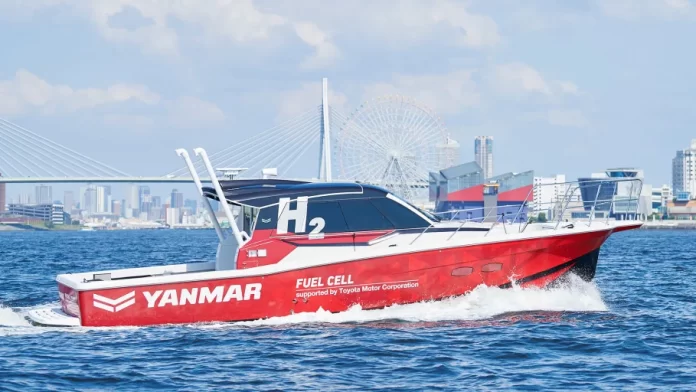Recent years have seen increasing efforts, all over the world, to reduce greenhouse gas (GHG) emissions towards the realization of a carbon neutral society. 123 countries and one region including Japan have already announced the goal of achieving net zero GHG emissions by 2050, and policies to reduce use of fossil fuels are being formulated around the world towards achieving this goal. For example, the European Commission recently announced its intention to ban the sale of new cars with gasoline and diesel-powered engines by 2035. At the same time, hydrogen is attracting worldwide attention as a clean energy source that can replace fossil fuels.
Yanmar has developed a fuel cell technology that uses hydrogen to produce electricity towards the realization of a carbon neutral society.
This article introduces the development of the maritime hydrogen fuel cell system for ships and its demonstration test. Behind the scenes, there was a lot of collaboration not only inside the Yanmar Group, but also with the government, local authorities, and private corporations representing related industries.Embedded media – Click here to see the full story in your browser
Video of the hydrogen fuel cell boat
Profile
 | Takehiro Maruyama New Power Source Group, Fundamental Technology Research Center, Research & Development Center, Innovation & Technology Division, Yanmar Holdings. Joined Yanmar in 2016. With his previous experience in fuel cell system development, he has been working as a project leader for the development of maritime hydrogen fuel cell systems since 2018. |
 | Takuya Hiraiwa System Engineering Division, Power Product Unit, Yanmar Power Technology. Joined Yanmar in 2012. He has participated in projects funded by the Ministry of Land, Infrastructure, Transport and Tourism. In this project, he is mainly in charge of safety design to meet the guidelines and standards related to the development of maritime hydrogen fuel cell systems. |
 | Yukihiko Kimura Marine Group, Solution Development Division, Development Division, Yanmar Marine International Asia. Joined Yanmar in 2013. He has worked in the development and testing and planning for recreational boats. He has participated in a variety of new boat development projects. In this project, he is in charge of designing the demonstration boat hull. |
The history of Yanmar’s maritime hydrogen fuel cell system development
In the maritime sector, the International Maritime Organization adopted a GHG reduction strategy in 2018, aiming to achieve zero emissions from international marine transportation as early as possible this century, as well as to improve emissions per unit of transport by at least 40% by 2030 and reduce total GHG emissions by at least 50% by 2050, both compared to 2008 levels. Recently, there have been discussions about moving up the schedule. At the same time, there are movements towards reducing NOx emissions in urban areas, environmentally protected areas, and large ports especially in Europe and the U.S.
Yanmar participated in projects funded by the Ministry of Land, Infrastructure, Transport and Tourism (MLIT) , and the Ministry of the Environment (MoE) to develop technology for maritime fuel cell systems, conduct demonstration tests of a fuel cell powered boat, and study shore-to-ship hydrogen refueling procedures.
Maruyama: From 2015 to 2017, Yanmar joined a project to research the development of “Safety Guidelines for Hydrogen Fuel Cell Ships”. Then, we joined a project to develop a “Roadmap for Deployment of Hydrogen Fuels Cell for Maritime Applications” funded by the Ministry of the Environment. Building on these experiences, we started a project to develop and test a maritime hydrogen fuel cell system on a test boat in 2019, using components from Toyota MIRAI fuel cell vehicle.
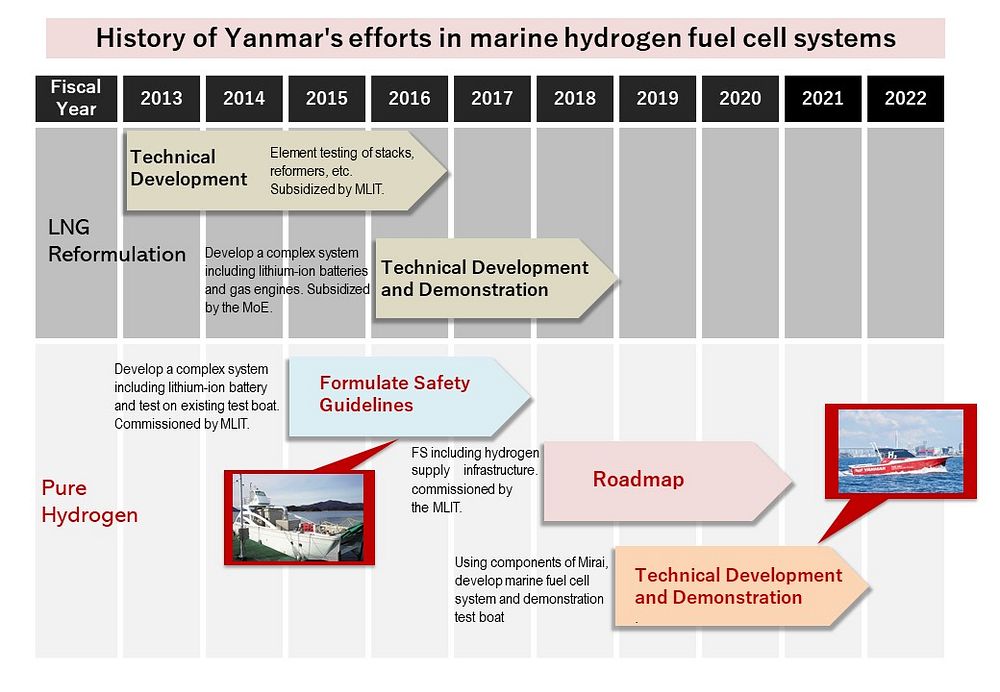 |
Advantages of hydrogen as a next-generation energy source.
Hydrogen has great potential as a next-generation energy source:
- It is the most abundant element on earth,
- It can be produced from water and electricity generated by renewable energy sources such as solar, wind, or geothermal,
- There are no CO2 emissions at the time of usage.
Q. Why has Yanmar been developing a maritime hydrogen fuel cell system?
Maruyama: It’s conceivable that regulations for carbon neutrality could be established in Yanmar’s business areas just as in the automobile industry. If that happened, we would have a responsibility to offer solutions to our customers that allow them to continue their business without it being said that they are not contributing to solving environmental problems. We believe hydrogen fuel cell systems will be one of the best decarbonization solutions for the realization of a sustainable society.
Hiraiwa: Our global competitors are already taking action towards a carbon neutral society. This would be an important opportunity not only for Yanmar but also for Japan to expand our business portfolio significantly by entering this new market. Traditionally Yanmar’s business models have been based on internal combustion engines, but we are embarking on a challenge to transform ourselves to a powertrain solution supplier that does not only depend on engines.
Kimura: By installing a fuel cell system on an actual boat and testing it, we can get many insights and discover important issues for future product development. Also, the experience gained and technologies developed in this demonstration are a vital resource to increase our competitiveness in the coming carbon neutral society.
Q. What are the advantages of maritime hydrogen fuel cells for electrifying the powertrain?
Maruyama: The electrification of the powertrain is an important part of a carbon neutral society. Current electric vehicles mainly use lithium-ion batteries, but for applications such as ships which require a large power output continuously over a long period, lithium-ion batteries suffer from poor performance in energy density and charging time. Hydrogen, on the other hand, has the advantage of a much larger energy density and a significantly shorter refueling time. Thus, hydrogen fuel cells are expected to be used especially in those applications in which these advantages are particularly important. Furthermore, unlike conventional engines, there is almost no noise, vibration or smell of exhaust gas since the electricity is generated in a electrochemical process. These advantages would create new customer value.
Yanmar Group, the government, and private sector work to build a demonstration boat for the practical implementation of maritime hydrogen fuel cell systems.
As stated in the Japanese government’s Basic Hydrogen Strategy, it is necessary to:
- Establish safety guidelines,
- Develop a roadmap for expanding the use of hydrogen,
- Develop and demonstrate technologies based on the roadmap.
Yanmar has been involved in these initiatives and has actively participated in MILT and MoE projects. Although there were a variety of technical and regulatory barriers, Yanmar overcome them together with companies from the automobile and hydrogen infrastructure industries, where hydrogen fuel cells had already been implemented, as well as the government, administrative agencies, and other companies.
Q. How were the safety guidelines developed?
Hiraiwa: When building a ship, it is necessary to follow the rules and guidelines set by the government and related organizations. MLIT assumed that hydrogen fuel cell systems would be implemented for smaller vessels rather than larger ones at the first phase, and in 2015, Yanmar joined a consortium in a project to develop the framework for “Safety Guidelines for Hydrogen Fuel Cell Ships”. Since it was the first project to consider this kind of guideline, the project team struggled to find a way forward. For example, there were questions like “What happens if a hydrogen fuel cell is immersed in seawater?” “What happens if the ship is rocking and tilting?” “What if there’s a hydrogen leakage?” The Project team investigated these questions with component tests in the lab as well as field tests. Based on the results, we discussed the framework for the safety guidelines with the MLIT.
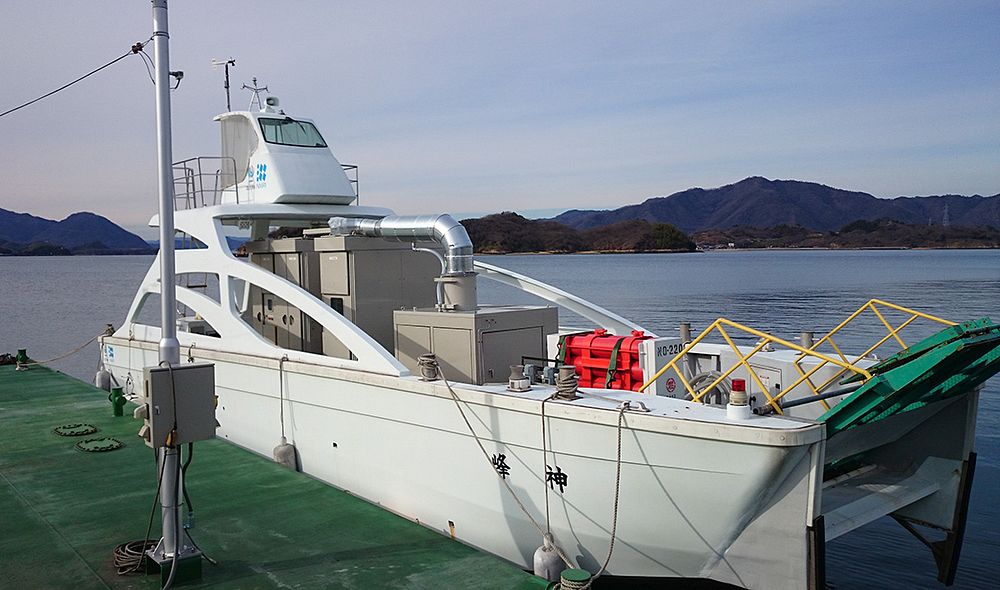 |
The test boat used in a project to develop the framework of the safety guidelines for hydrogen fuel cell ships.
A demonstration boat equipped with a maritime hydrogen fuel cell system
Amid a climate of an increasing shift to a carbon neutral society, Yanmar and partners completed the development of the safety guidelines. Yanmar the redoubled its efforts into the development of a maritime hydrogen fuel cell system. The safety guidelines define not only the requirements for hydrogen fuel cell systems, but also the requirements for their installations into ships. Thus, Yanmar decided to build a demonstration test boat to consider all of these elements. However, the construction of the demonstration test boat was not possible by the initial members of the project in Innovation and Technology Division, and Yanmar Power Technology alone.
Q. Many people were involved in the construction of the demonstration boat, weren’t they?
Maruyama: To build a demonstration test boat, we almost had to develop a whole new boat. We had to develop an electric powertrain that included not only the fuel cell system but also other components such as lithium-ion batteries and a motor as well as the power management software. We also had to design a new hull and the boat required a special hydrogen refueling facility. Since the initial project members could not handle these tasks alone, we consulted many people, both inside and outside the company, to get their support and participation in the project. Some were initially hesitant to cooperate with us, so we repeatedly explained the significance of this demonstration test and our vision for the future. Eventually, we were able to secure many collaborations in both within the Yanmar Group as well as with external partners such as Toyota Motor Corporation, Iwatani Corporation, Toyota Tsusho Corporation, and many other companies, while government agencies, such as MLIT and Osaka Prefectural Government also supported the project.
For the hull design of the demonstration test boat, we asked Kimura from Yanmar Marine International Asia to join us with his substantial experience in designing various kinds of new test boats.
Q. What was the most difficult part of building the demonstration boat?
Kimura: The components of the powertrain for propulsion are quite different from the conventional diesel engine-powered boats which are designed in matured and standardized processes. In the case of the fuel cell demonstration boat, there were many components that had to be installed and work together such as fuel cell systems, motors, inverters, power distribution boxes, battery packs and hydrogen tanks etc. There was no standardized process to design fuel cell-powered boats, but even so, we had to ensure the safety of the boat in any operating conditions in the field.
Maruyama: The most important point in the construction was to meet the safety design requirements of the boat based on the guidelines. This was also necessary to get the approval for the demonstration test. Hiraiwa dealt with this point by communicating with MLIT and the Japan Craft Inspection Organization (JCI).
Kimura: In practice, we found some of the requirements in the guidelines were not realistic for this type of boat. In such cases, we proposed alternative designs to ensure the same level of safety as that required in the guideline. Hiraiwa led the coordination with MLIT and JCI.
It was quite difficult to find space to install the eight hydrogen tanks. The guidelines require a certain clearance from the side and bottom wall of the boat to ensure that the tanks are not damaged in case of collision or stranding. While I was struggling to fit them in, I asked myself, “Should I just install the tanks on the ceiling of the cabin? Like a samurai chonmage topknot?” (laughs)
Hiraiwa: In the end, all the components were properly installed under the deck. The construction proceeded from scratch – there was no precedent. It was not at all like making improvements to a conventional diesel engine-powered boat. I really admire Kimura’s ability to design the boat from the ground up with innovative ideas.
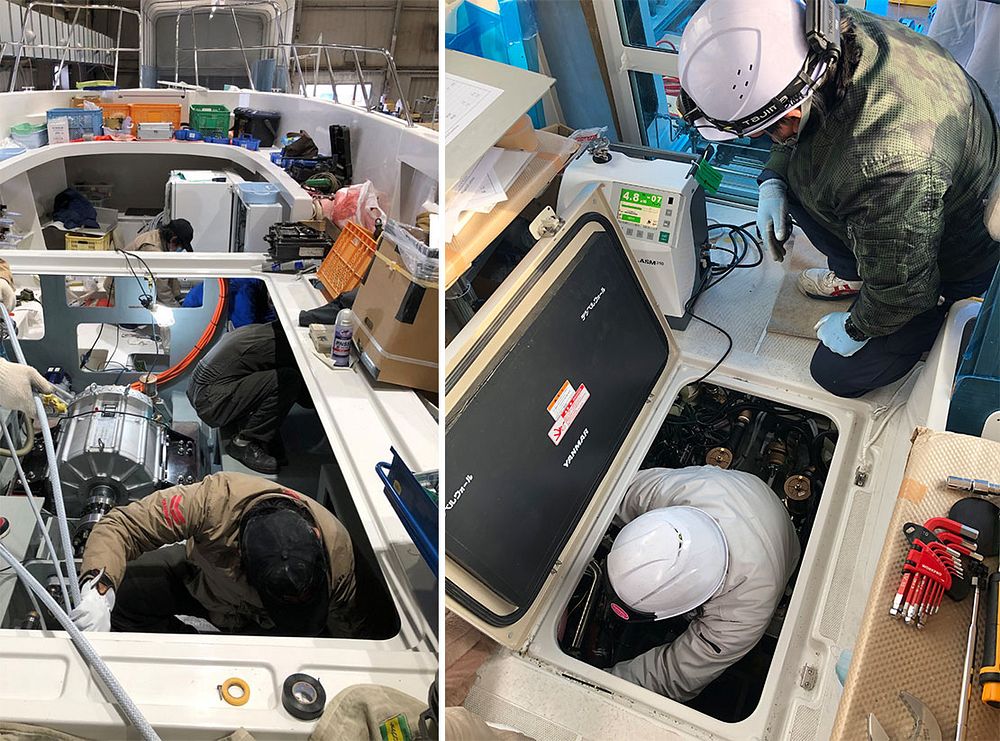 |
The construction of the demonstration test boat.
Q. Was the Covid-19 pandemic also a major obstacle?
Maruyama: I think that Kimura had a tremendous amount of trouble with the pandemic. He is based in Oita which is around 500 kms away from Osaka and Shiga where Hiraiwa and I are based. The hull was designed in Oita, while the most of the components, including the hydrogen fuel cell system and lithium-ion battery system, were designed in Osaka and Shiga, and made and tested in Shiga. Kimura was not able to travel due to the pandemic, so he couldn’t look at the components in person.
Kimura: In a boat hull design process, it’s very important to understand the detailed specifications of the components such as their operating temperature, weight, vibration characteristics as well as how they are used. Maruyama shared a huge amount of photos and data so that I could still have a good understanding of the components, even if I could not examine them in person.
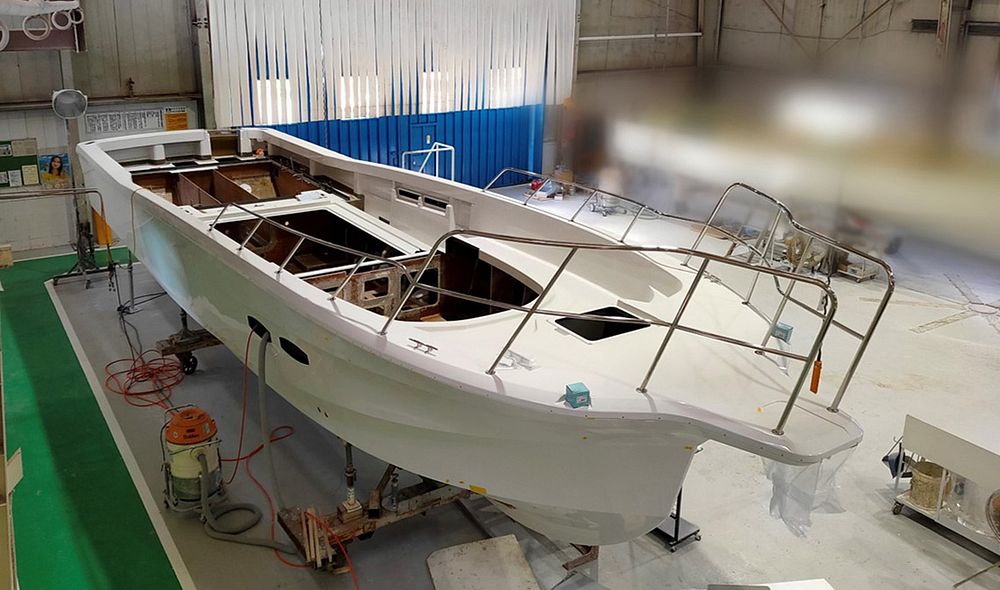 |
The demonstration test boat in the construction phase.
Completion of the demonstration test boat
With the support of many partners, the efforts of project team bore fruit and construction of the futuristic looking demonstration test boat was completed successfully. The boat received approval from JCI and demonstration tests commenced in March 2021.
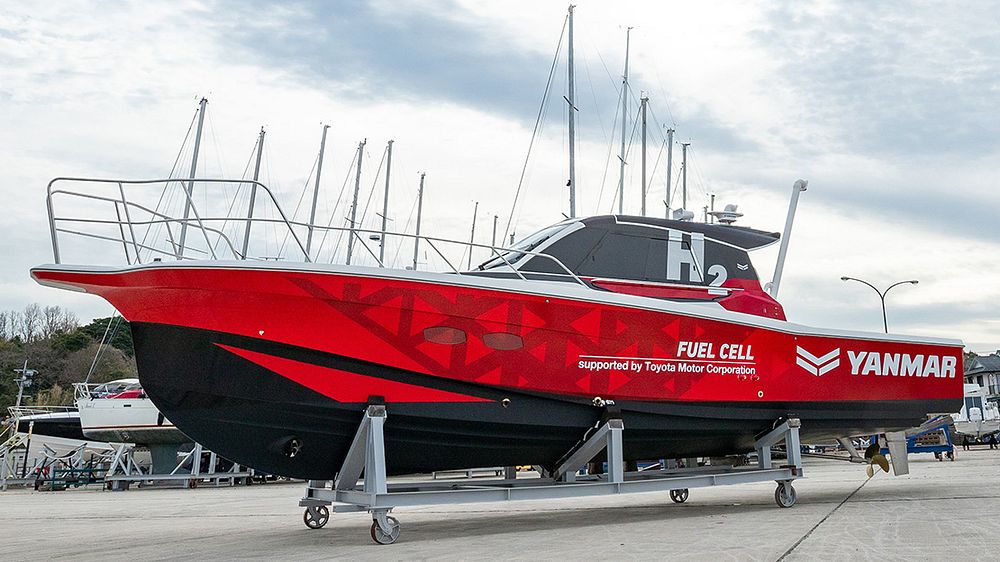 |
The completed demonstration boat.
Q. What was your impression of the completed boat?
Kimura: My colleagues said: “It was amazing that a 38-foot boat could run at over 20 knots with an electric motor”. Of course, there is no smell of diesel oil, or smoke, and it’s very quiet. Also, the acceleration is quite good compared to diesel engine-powered boats due to the features of the electric motor. I think that people who ride on the boat will appreciate it for its comfortable ride.
Q. What testing did you do and what did you learn in the demonstration test?
Maruyama: First, we made test runs in Oita, including adjustments of the electric powertrain control software, then verified the performance of the hydrogen fuel cell system under actual navigation conditions. This September, the test boat was moved to Osaka Bay and we refueled the boat with the 70MPa high-pressure hydrogen refueling station (world’s first demonstration of this kind for maritime applications). The boat ran a route connecting the planned site of the Osaka-Kansai Expo with tourist spots along the city’s coast. The results of these tests will be utilized in the future development of maritime hydrogen fuel cell system products and the investigation of hydrogen refueling infrastructure for ships.
In particular, we had a media event in Osaka Bay and had an amazing response from all over the world. We’d like to work together with those people towards a carbon neutral society.
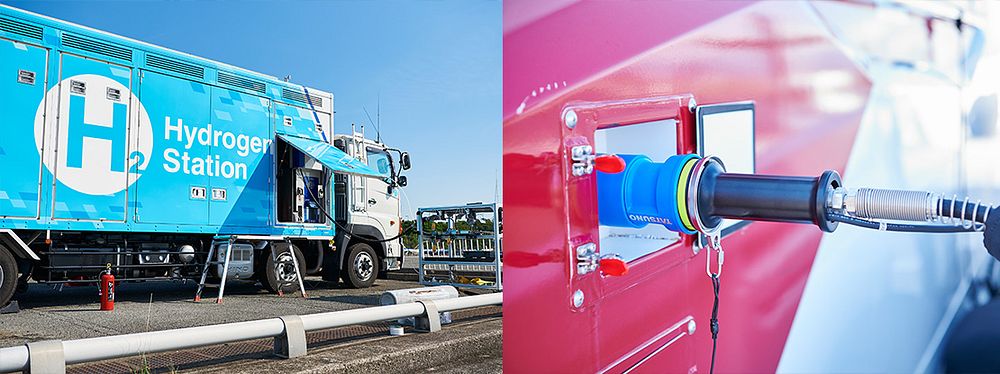 |
High-pressure hydrogen refueling test at 70MPa.
Hiraiwa: Compared to just desktop studies, we learned a lot by building the demonstration boat and testing it. In addition, through our media activities, we have been contacted not only by potential customers but also by various hydrogen and marine organizations in Japan and overseas. I realized the impact of actually getting the demonstration done, and feel that we have actually enhanced our capabilities and gained a lot of experience through the process of design, construction, and demonstration testing.
Kimura: The demonstration boat is so quiet that we can hear the natural sounds of the ocean. It’s something you can’t experience when you’re on a diesel engine-powered boat. From a boat building, navigation and service perspective, since the boat contains many components that are not installed in diesel engine-powered boats, and the actual weight of the boat is heavier, we need to start thinking about how we can make the fuel cell systems and components lighter and more compact.
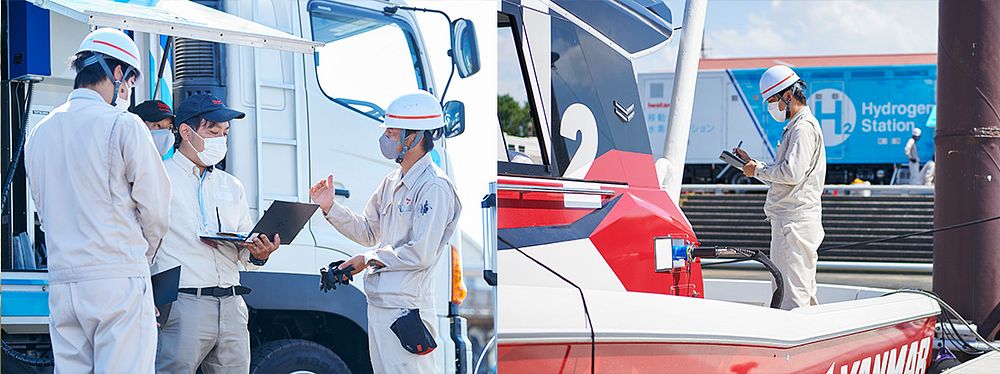 |
Demonstration of high-pressure refueling.
Towards a carbon neutral society
Around the world, development and commercialization of technologies continues towards the realization of a carbon neutral society. Electrification of the powertrain is one of the most important topics. Yanmar’s electric powertrain with hydrogen fuel cell systems will be utilized not only for maritime applications but also for land applications.
Target of Yanmar’s Hydrogen Fuel Cell System and business:
- 2023: Commercialization of 300 kW-class Maritime hydrogen fuel cell system.
- 2025: Deployment at Osaka-Kansai Expo and carbon neutral ports etc.
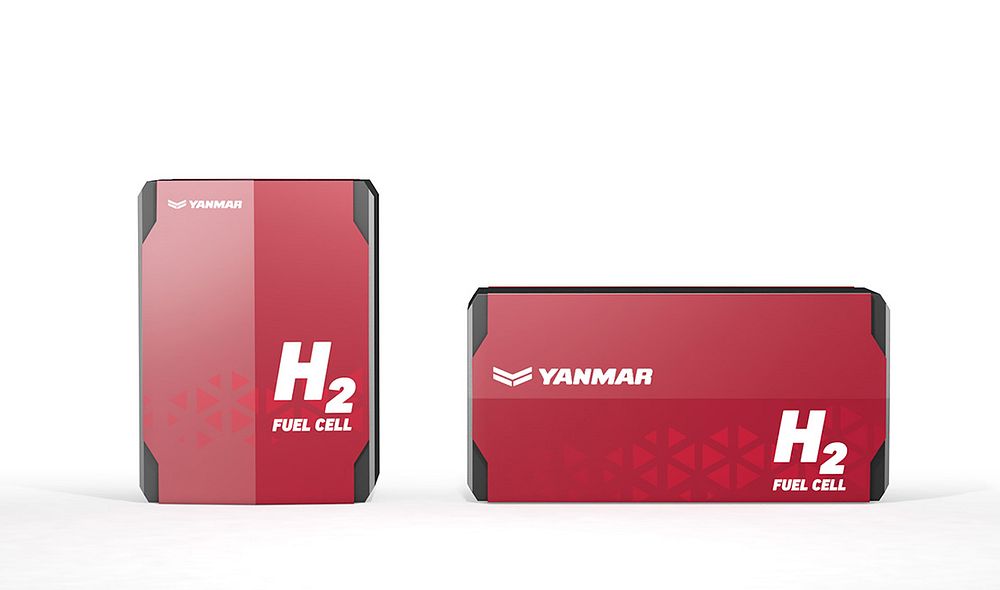 |
Image of 300kW-class maritime hydrogen fuel cell system.
Q: What would you like to achieve with hydrogen?
Maruyama: The ultimate goal is to complete our shift to a carbon neutral society. In our business fields, the first step is to commercialize the maritime hydrogen fuel cell system. We think we can expand the technology and business to land applications such as generator sets.
Through this demonstration project, we established many relationships with related industries and government institutions. I would like to take various approaches to build on these relationships towards realization of a carbon neutral society.
Hiraiwa: I believe that our mission is to develop powertrain systems that combine hydrogen fuel cell systems and hydrogen engines etc., and to bring them to global markets.
Kimura: I would like hydrogen refueling stations for maritime applications to be deployed at ports and marinas. It doesn’t matter how much hydrogen fuel cell-powered boats advance if they don’t have the hydrogen fuel infrastructure to run on. Development of hydrogen infrastructures for maritime applications is an important topic.
Final Notes
In this interview, we spoke with Maruyama, Hiraiwa, and Kimura. They all expressed their gratitude for the support of many people, not only in Yanmar group, but also in the government, administrative agencies, various related companies and organizations.
Help keep news FREE for our readers
Supporting your local community newspaper/online news outlet is crucial now more than ever. If you believe in independent journalism, then consider making a valuable contribution by making a one-time or monthly donation. We operate in rural areas where providing unbiased news can be challenging. Read More About Supporting The West Wales Chronicle






















